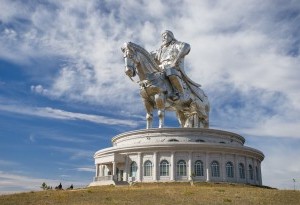Genghis Khan Equestrian Statue, Tsonjin Boldog

On the bank of the river Tuul, which is 54 km east of Ulan Bator, stands a majestic forty-meter statue of Genghis Khan sitting on a horse - the tallest equestrian statue in the world. There are 36 columns around it, symbolizing the 36 Khans, who headed Mongolia after Genghis Khan.
There is no person in the world who would not hear this name of the cruel Mongol conqueror, who conquered a large part of the world in the 13th century; warrior who sow destruction and death around him. But not everyone knows what an important role Chinggiskhan played in the fate of Mongolia, because he was the founder of the Mongol Empire, colossal than which mankind did not know in its entire history.
The statue of Genghis Khan is considered one of the nine wonders of Mongolia and the main symbol of the state. For all the Mongolian people, this monument is of great importance, because for him, Genghis Khan is the man with whom the history of the nation begins.
The statue of Genghis Khan is considered one of the nine wonders of Mongolia and the main symbol of the state.
The monument to Genghis Khan is more than just a statue. It is installed on a round base with a diameter of 30 meters and a height of 10 meters. Plus, the equestrian statue itself is hollow and consists of two floors. Inside the complex there are several interesting sites that are definitely worth a visit. The pedestal houses the historical museum dedicated to the Mongol khans; a huge map on which you can trace all the conquests of the great Genghis Khan; art Gallery; conference hall; several restaurants; billiards room; souvenir shop.
The opening of the monument, which took 250 tons of stainless steel, took place in 2008 after three years of construction. Today, the statue of Genghis Khan is one of the most popular sights of Mongolia.
The place where the huge steel Genghis Khan towers on the hill has its history associated with the great warrior. According to legend, this is where the history of the Mongol Empire as a whole originates. In 1177, the young Temüjin, who in the future took the name of Genghis Khan, discovered a golden whip on the top of the hill, which symbolized good luck. For Temüjin, this find was a sign that the gods favored him in fulfilling his dream of uniting the Mongols scattered around the nomadic tribes. He fulfilled his plans: in 1206 the Great Mongolian Empire was formed by his forces, and a copy of the famous golden whip can still be seen inside the base of the statue.
In addition to the whip, the visitor is offered to try dishes according to traditional Mongolian recipes, play a game of billiards or take the elevator to the observation deck, located in the head of Genghis Khan's horse. From there, from a height of thirty meters, offers a stunning view of the mountains and plains, on the endless fascinating Mongolian steppes. This panorama is especially beautiful in spring when tulips bloom everywhere.
Today, around the statue of Genghis Khan, the eponymous theme park is being built, dedicated to the era of his rule and the characteristics of the life of the Mongolian people in those times. There is also a version that the future cultural-historical complex will be called the “Golden Whip”. It is planned to divide the park into six parts: the camp of warriors, the camp of artisans, the camp of the shamans, the yurt of the khan, the camp of the pastoralists and the educational camp. It is also supposed to decorate the park with an artificial lake and smash an outdoor theater. The total estimated area of the park is 212 hectares.
Join our tours and take a look at this amazing attraction:
www.uvisitrussia.com/tours-to-trans-siber/



